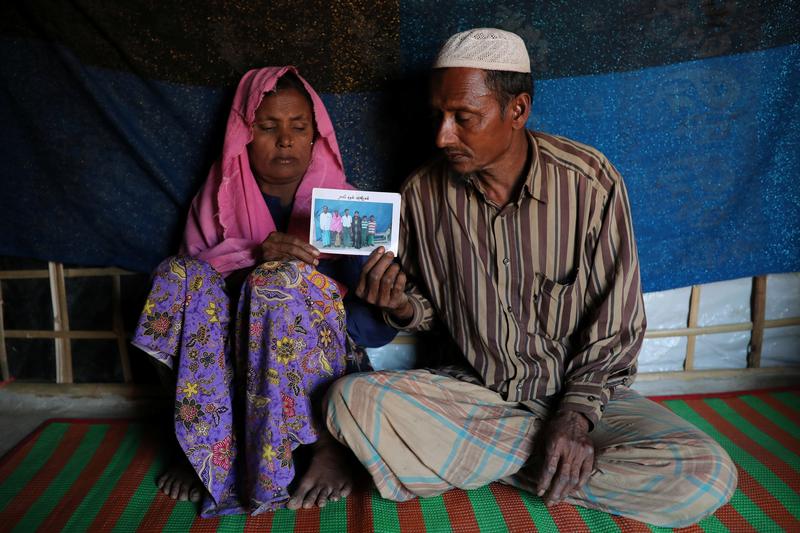With 1.2 million refugees originating from Burma and tens of thousands more uprooted inside the country, the Southeast Asian nation was the source of the fourth-largest population of displaced people worldwide at the end of 2017, a new report by the UN refugee agency (UNHCR) finds.
Over half of refugees from Burma were members of the Rohingya Muslim minority displaced in 2017 following brutal “clearance operations” launched by state security forces in response to militant attacks claimed by the Arakan Rohingya Salvation Army (ARSA) in August. According to UNHCR’s annual “Global Trends” report released on Tuesday, 655,500 refugees crossed Burma’s western border into neighbouring Bangladesh last year, the vast majority being Rohingya in the aftermath of the ARSA attacks.
Due predominantly to civil wars and ethnic and religious persecution, 68.5 million people were forcibly displaced internally or to other countries through the end of 2017 — setting a new record high in a trend that has continued over the past five years. Sixty-eight percent of the latter population, classified as refugees, come from just five beleaguered countries: Syria, Afghanistan, South Sudan, Burma and Somali, at more than 13.4 million altogether.
Worldwide, an average of 44,400 people were displaced every day last year. In a press release accompanying its report, UNHCR said “the world had almost as many forcibly displaced people in 2017 as the population of Thailand. Across all countries, one in every 110 persons is someone displaced.”
In a statement released on World Refugee Day, June 20, UN High Commissioner for Refugees Filippo Grandi called for change in how the world tackles the issue of displacement.
“Now, more than ever, taking care of refugees must be a global — and shared — responsibility. It’s time to do things differently,” he said.
“A new model is now being tested, with positive results — based on equity, on justice and on humanitarian values and standards. Countries and communities need more systematic, long-term support as they take on the job of helping uprooted families. Refugees themselves need to be included in new communities, and given the chance to realise their potential.”
Across refugee populations globally, minors accounted for just over half of all refugees — placing them at particular risk of human trafficking, forced labour and sexual assault. Reuters has report that Rohingya girls are being confined to their camps due to safety concerns, further curbing their already limited access to education and healthcare. At least one in five displaced women have experienced sexual violence, according to UN Women, a figure that supports the claims of Rohingya women, many of whom presented to refugee camps with injuries from rape and sexual torture.
The UNHCR report said other countries with large populations of refugees from Burma were Thailand (100,000), Malaysia (98,000) and India (18,100).
Burma’s stateless
Rendered stateless by Burma’s 1982 Citizenship Law, , according to the UN refugee agency. But in the months after the August 2017 attacks by ARSA, military operations resulted in the flight of more than half of that population. Overall, the UN says the number of Rohingya refugees from Burma now living in Bangladesh totals more than 900,000, due to successive waves of displacement over decades. Another 125,000 internally displaced Muslims remain in camps in Arakan State, where their freedom of movement and access to basic healthcare and education is limited.
The 1982 Citizenship Law, if not amended, is likely to make it nearly impossible for most Rohingya displaced to Bangladesh to return to Burma, critics say. Despite government assurances that a repatriation programme is in place to process returnees, many Rohingya — who some observers have labelled “the world’s most persecuted” — lack documentation proving their claims to long-time residence in Burma.
Reports have indicated that Naypyidaw is insisting only those holding identification documents will be eligible to return, leaving most stuck in a no-man’s land of bureaucratic hurdles.
Burma signed a Memorandum of Understanding with UN agencies in early June in a bid to facilitate the “voluntary, safe, dignified and sustainable” return of refugees back to Rakhine State.
Speaking to DVB at the time, UNHCR country representative Giuseppe de Vincentiis said the agency was willing to provide “technical support” but added that citizenship remains a sovereign issue for Burma to address.
In a Washington Post op-ed published ahead of World Refugee Day, James Lynch, Southeast Asia regional representative for UNHCR, said the current conditions are “not yet conducive to a safe and dignified return.”
Government spokesperson Zaw Htay was unavailable for comment both in early June and at the time of this story’s publication.
Ongoing displacement in the north
In northern Burma, civilians continue to be displaced by fighting between ethnic armed groups and the Burma Army that has flared with regularity for years. According to a UN Office for the Coordination of Humanitarian Affairs “snapshot” report published in May, more than 103,000 displaced people are living in camps in Kachin and northern Shan states.
[related]
The lesser-known conflict has ignited peace demonstrations by Burmese activists in major cities, including the commercial hub Yangon and Kachin State’s capital Myitkyina. Forty-seven peace demonstrators are facing charges for their protests, according to peace activist Thinzar Shunlei Yi.
While the plight of the Rohingya has captivated the international community, the long-running conflict that has uprooted many in Burma’s north is comparatively less reported. But both flashpoints have earned Burma the unenviable fourth place position in the tallying of countries of origin for the world’s most displaced persons.



